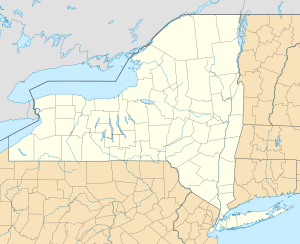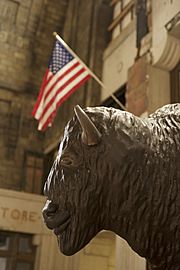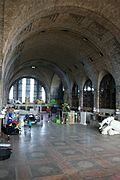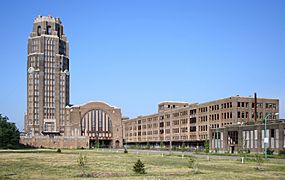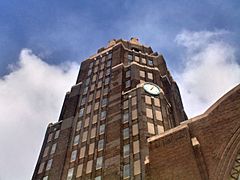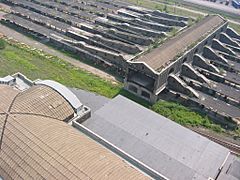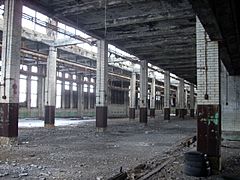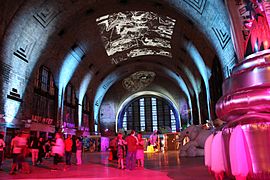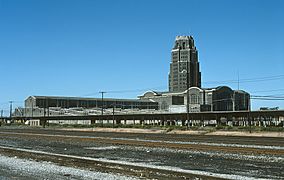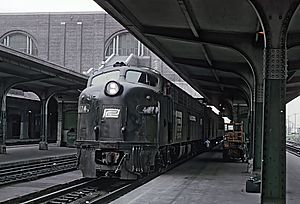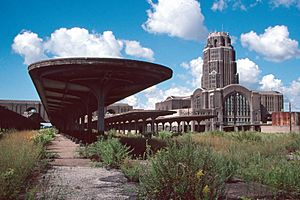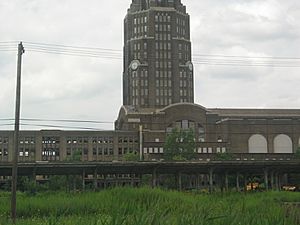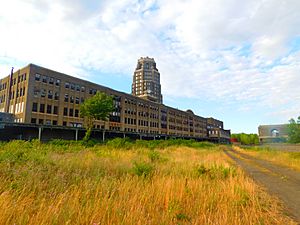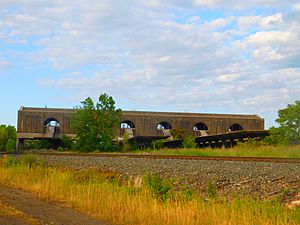Buffalo Central Terminal facts for kids
Quick facts for kids
Buffalo Central Terminal
|
|||||||||||||||||||||||||||||||||||||||||||||||||
|---|---|---|---|---|---|---|---|---|---|---|---|---|---|---|---|---|---|---|---|---|---|---|---|---|---|---|---|---|---|---|---|---|---|---|---|---|---|---|---|---|---|---|---|---|---|---|---|---|---|
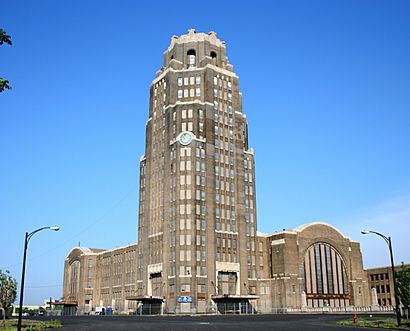 |
|||||||||||||||||||||||||||||||||||||||||||||||||
| Location | 495 Paderewski Drive, Buffalo, New York |
||||||||||||||||||||||||||||||||||||||||||||||||
| Coordinates | 42°53′23″N 78°49′49″W / 42.88972°N 78.83028°W | ||||||||||||||||||||||||||||||||||||||||||||||||
| Line(s) | Empire Corridor (Buffalo Terminal Subdivision) | ||||||||||||||||||||||||||||||||||||||||||||||||
| Platforms | 14 island platforms | ||||||||||||||||||||||||||||||||||||||||||||||||
| Tracks | formerly 28 | ||||||||||||||||||||||||||||||||||||||||||||||||
| Other information | |||||||||||||||||||||||||||||||||||||||||||||||||
| Station code | BUF (former) | ||||||||||||||||||||||||||||||||||||||||||||||||
| History | |||||||||||||||||||||||||||||||||||||||||||||||||
| Opened | June 22, 1929 | ||||||||||||||||||||||||||||||||||||||||||||||||
| Closed | October 28, 1979 | ||||||||||||||||||||||||||||||||||||||||||||||||
| Former services | |||||||||||||||||||||||||||||||||||||||||||||||||
|
|||||||||||||||||||||||||||||||||||||||||||||||||
|
Buffalo Central Terminal
|
|||||||||||||||||||||||||||||||||||||||||||||||||
| Location | Buffalo, New York | ||||||||||||||||||||||||||||||||||||||||||||||||
| Area | Buffalo Broadway/Fillmore district | ||||||||||||||||||||||||||||||||||||||||||||||||
| Built | 1929 | ||||||||||||||||||||||||||||||||||||||||||||||||
| Architect | Fellheimer & Wagner | ||||||||||||||||||||||||||||||||||||||||||||||||
| Architectural style | Art Deco | ||||||||||||||||||||||||||||||||||||||||||||||||
| NRHP reference No. | 84002389 | ||||||||||||||||||||||||||||||||||||||||||||||||
| Added to NRHP | September 7, 1984 | ||||||||||||||||||||||||||||||||||||||||||||||||
The Buffalo Central Terminal is a famous old train station in Buffalo, New York. It was a busy station from 1929 to 1979. This 17-story building is designed in the Art Deco style. Architects Fellheimer & Wagner created it for the New York Central Railroad.
After being empty for many years, a group called the Central Terminal Restoration Corporation bought it. This non-profit group is working to fix up the building. They want to give it new uses. The Central Terminal is located in Buffalo's Broadway/Fillmore area.
Contents
Exploring the Terminal's Design
The terminal is about 2.5 miles (4.0 km) from downtown Buffalo. It has several buildings. Some are connected, and others used to be.
Main Areas Inside
The main concourse is a huge hall. It is 225 feet (69 m) long and 58.5 feet (17.8 m) tall. This area once had shops, a restaurant, and a telegraph office. There was also a soda fountain. A streetcar lobby and waiting room were also part of it. The Central Terminal Restoration Corporation owns this main concourse today.
The train concourse is 450 feet (137 m) long. It has 14 platforms where trains would stop. You could reach each platform by stairs and a ramp. Amtrak owns this part, and CSX owns the land. In 1982, a bridge connecting the train concourse to the main building was taken down. This allowed taller freight trains to pass.
Important Buildings
The office tower is 15 stories tall. This 271-foot (83 m) building is also owned by the Central Terminal Restoration Corporation.
The baggage building is next to the main concourse. It is a five-story building. The mail building is a two-story building near the baggage building. The City of Buffalo owns the mail building.
The Railway Express Agency building is behind the mail building. It was like an early version of Federal Express or UPS. Trains could pull right inside to load and unload goods. This building is in poor condition. The City of Buffalo plans to take it down.
Buildings That Are Gone
Some buildings were torn down in 1966. These included a Pullman Company service building and an ice house. A coach shop was also removed. This was done to lower property taxes.
The first building built for the terminal was a cogeneration power station. It made heat and electricity for the whole complex. It had three large coal boilers. Its smokestack was removed in 1966 to save money on taxes. The power plant itself was used until the mid-1980s.
A Look Back at the Terminal's History
Building the Terminal (1925–1929)
In the early 1900s, Buffalo had several train stations. People wanted one big station for all trains. The New York Central Railroad (NYC) had two old stations in downtown Buffalo. They were often crowded.
NYC decided to build a new, larger station outside downtown. This would help with train traffic and make it easier to transfer sleeping cars. Buffalo was growing fast, and they thought the new terminal would soon be in the city's center.
NYC started planning in 1925. They hired Alfred T. Fellheimer and Steward Wagner to design the station in 1927. The whole project cost $14 million.
The station officially opened on June 22, 1929. A big party was held with 2,200 guests. The first train left that day at 2:10 PM. Regular train service began on June 23.
Early Years and Decline (1929–1979)
When it first opened, the station was used by the NYC, Canadian National Railway, Pennsylvania Railroad, and Toronto, Hamilton & Buffalo Railway.
The station was very large. But soon after it opened, the Great Depression began. Also, more people started using cars. This meant fewer trains and passengers.
During World War II, the station became very busy again. Many soldiers and supplies passed through. Famous trains like the Wolverine and Lake Shore Limited stopped here daily.
After the war, train travel declined across the country. In 1956, the New York Central tried to sell the terminal for $1 million. It didn't sell. In 1966, parts of the building were torn down to save money.
In 1968, the NYC merged with another railroad to form Penn Central Transportation. This company ran the terminal until Amtrak was created in 1971. Amtrak took over passenger train service.
Amtrak found the Central Terminal too big and expensive to run. In 1979, Amtrak moved its services to a smaller station, Buffalo-Depew station, about 10 miles east. The last train left Central Terminal on October 28, 1979.
After the Trains Left (1979–Present)
After Amtrak left, the building was sold to Anthony T. Fedele for $75,000. He hoped to turn it into a hotel and offices. He even lived in the building for a while. During his ownership, the terminal was added to the National Register of Historic Places in 1984. This meant it was protected from being torn down.
Later, the building was sold to Thomas Telesco. During this time, many valuable items were taken from the building. Things like iron railings, signs, and lights were sold. The building was not secure, and there was a lot of damage from people breaking in and even trying to set fires.
In 1997, a group called the Central Terminal Restoration Corporation (CTRC) bought the building for just $1. They also took on about $70,000 in old taxes. The CTRC is a group of volunteers. Their goal is to save the terminal and help it be used again.
Since then, the CTRC has done a lot of work. They fixed and relit the tower clocks in 1999. They also got a grant to help protect the complex. The building was reopened for public tours in 2003.
Today, the Buffalo Central Terminal hosts many events. These include fundraising events, art shows, and train shows. It also hosts annual Dyngus Day and Oktoberfest parties. Over 100,000 people have visited the building since 2003.
In 2003, the original clock from the concourse was found in Chicago. It was bought back in 2004 with help from donations. The clock is now back in its original spot in the main concourse.
The terminal has even been featured on TV shows. The paranormal investigators from Ghost Hunters visited in 2008 and 2009. They even did a live Halloween broadcast from the station in 2010.
In 2016, a developer from Toronto, Harry Stinson, was chosen to help fix up the terminal. His plan included turning it into a mixed-use building. It also suggested bringing back train services. However, in 2017, the CTRC decided to work with another group, the Urban Land Institute, instead.
In 2017, the World Monuments Fund added Central Terminal to its 2018 Watch List. This list highlights important places around the world that need help. In 2018, 200 solar panels were installed. This brought commercial electricity back to the building.
What's Next for the Terminal?
CTRC's Future Plans
The Central Terminal Restoration Corporation (CTRC) has big plans for the terminal's future. They want to make it a useful place again. This includes fixing the roof and installing solar panels. They are also working on cleaning up and repairing other parts of the building.
The CTRC hopes that trains might return to the terminal someday. This could include local light rail or even high-speed rail. Buffalo is part of the Empire Corridor, which is a special area for high-speed rail in the United States.
Amtrak's Future in Buffalo
In 2016, the roof of the downtown Exchange Street Amtrak station collapsed. This made people talk about building a new train station in Buffalo. Some suggested moving the Amtrak stop back to the Central Terminal.
Congressman Brian Higgins supported studying the Central Terminal as a possible new station site. He believed it could work as a "station-within-a-station." This would allow trains to serve the city again. Senator Charles Schumer also agreed.
In 2017, a panel approved a downtown location for a new station instead. However, the Central Terminal's future remained a topic of discussion.
New Studies and State Support
In May 2017, the CTRC, the City of Buffalo, and New York State decided to have the Urban Land Institute study the terminal. This group helped successfully reuse another famous Buffalo building. They looked at the terminal and its neighborhood to suggest new uses.
The study suggested reopening the concourse as a year-round event space. They also recommended improving the green spaces around the building.
On April 13, 2018, Governor Andrew Cuomo announced $5 million in funding. This money will help restore the concourse. It will also create a space for events, catering, and entertainment. The CTRC is also expected to have a professional staff to help with the restoration.
Timeline of Key Events
- 1925: People realize Buffalo needs a new, bigger train station.
- 1929: The Buffalo Central Terminal officially opens on June 22.
- 1940s: Train travel increases during World War II.
- 1956: The terminal is put up for sale but doesn't find a buyer.
- 1966: Some buildings are torn down to save money.
- 1971: Amtrak takes over passenger train service at the terminal.
- 1979: Amtrak stops using the terminal on October 28.
- 1984: The terminal is added to the National Register of Historic Places. This protects it from demolition.
- 1986-1997: The building is neglected and damaged by vandals.
- 1997: The Central Terminal Restoration Corporation (CTRC) buys the terminal for $1.
- 1999: The tower clocks are relit.
- 2003: The terminal opens for public tours after repairs.
- 2005: The original concourse clock is bought back and returned to the terminal.
- 2008: The TV show Ghost Hunters films an episode at the terminal.
- 2011: A new fiberglass buffalo statue is placed in the main concourse.
- 2016: Parts of the concourse are restored for the movie Marshall.
- 2018: New York State provides $5 million for restoration. Solar panels are installed.
Terminal Statues
The station once had a stuffed American bison in the concourse. It was used to advertise the Buffalo Museum of Science. Passengers would rub their hands on it, making it worn. It was replaced with a plaster statue. This plaster statue was later accidentally broken. A new fiberglass buffalo statue was placed in the terminal in 2011.
After the station closed, a statue called "Progress" was placed outside. It was said to be of Madonna and Child. This statue was damaged when someone tried to move it.
Images for kids


